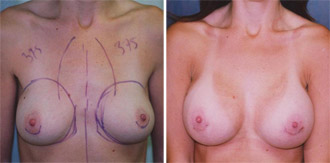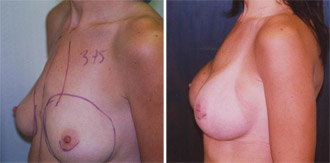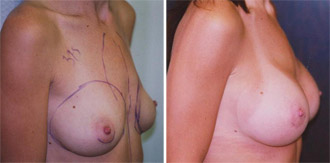PECTUS CARINATUM BREAST SURGERY
Posted On: May 10, 2011 Author: The Office of Dr. Stuart Linder Posted In: Breast Augmentation, Breast Implants, Breast topics, Plastic Surgery
Sternal chest wall deformity or Pectus Carinatum Deformity is associated with a pigeon chest appearance, associated with deformity and protrusion of both the ribcage and the sternum. This anomaly congenitally is often referred to as a pigeon chest. There is bowing outward externally of the chest wall. It usually occurs as a solitary abnormality that may be associated with other genetic disorders or syndromes. It is contrary to pectus excavatum, which is associated with contour depression deformity of the midline or sternum. The etiology of pectus carinatum is when the sternum does not lie flat and rather it is a congenital deformity in which the costochondral junction and the midline sternum protrude anteriorly.
We operate on patients in our Beverly Hills practice with pectus carinatum, although it does not appear to be as frequent as the pectus excavatum patients that we see. The sternal deformity should always be evaluated for other abnormalities or other syndromes.
What occurs is the sternum protrudes and there is a narrow depression along the sides of the chest which gives a bowed out appearance to the chest wall similar to that of a pigeon chest. Normally, these patients have normal heart and lungs. Patients with pectus carinatum aesthetically can be improved with breast augmentation by placing subpectoral implants in the dual plane technique using high profile saline or silicone gel implants.
It is seen in approximately one in 400 births. People who have pectus carinatum normally have normal development of both the cardiac and pulmonary systems. These patients present with an outward rigidity of the chest wall. They can be associated with asthma as well as pulmonary insufficiency. Some children with the pectus carinatum may also present with scoliosis or lumbar lordosis which is a curvature in the spinal cord and vertebral column. It may also be associated with a mitral valve prolapse. The prognosis is usually excellent for pectus carinatum and surgical treatments can include surgical release of the costochondral junction as well as the sternum with repositioning with wires and/or rods. Some patients will have bracing as a first line treatment which of course is a noninvasive method of correction.
Below you will see examples of pectus carinatum that are somewhat correctable in patients who have significant pigeon chests or pectus carinatum. In order to reduce this effect, the implants can be placed in the subpectoral pocket. Care must be taken to avoid a pneumothorax and therefore a small cuff of muscle is maintained on the parasternal ridge and along the costochondral junction. Our patients are instructed that cleavage postoperatively will be affected by the carinatum and that the implants will be laterally displaced by the chest wall and that to minimize this there should be less dissection lateral to the areola which will allow for enhanced cleavage and a reduction in the visualization of the carinatum. Deformity of pectus carinatum are seen in my practice monthly; however, the severe cases can make it quite difficult to establish any cleavage unless significantly larger implants are used. Conservative size implants usually lead to lateral displacement of the implants over time with lack of cleavage when patients do not wear bras. Wearing the Dr. Linder Bra, extra small size post perioperative period may help to allow for compression of the implants and an enhanced cleavage as well. Pectus carinatum, although not all that common, seen in one in 400 patients, can be correctable by thoracic surgical procedures if severe and if patients present with pulmonary cardio insufficiency.


